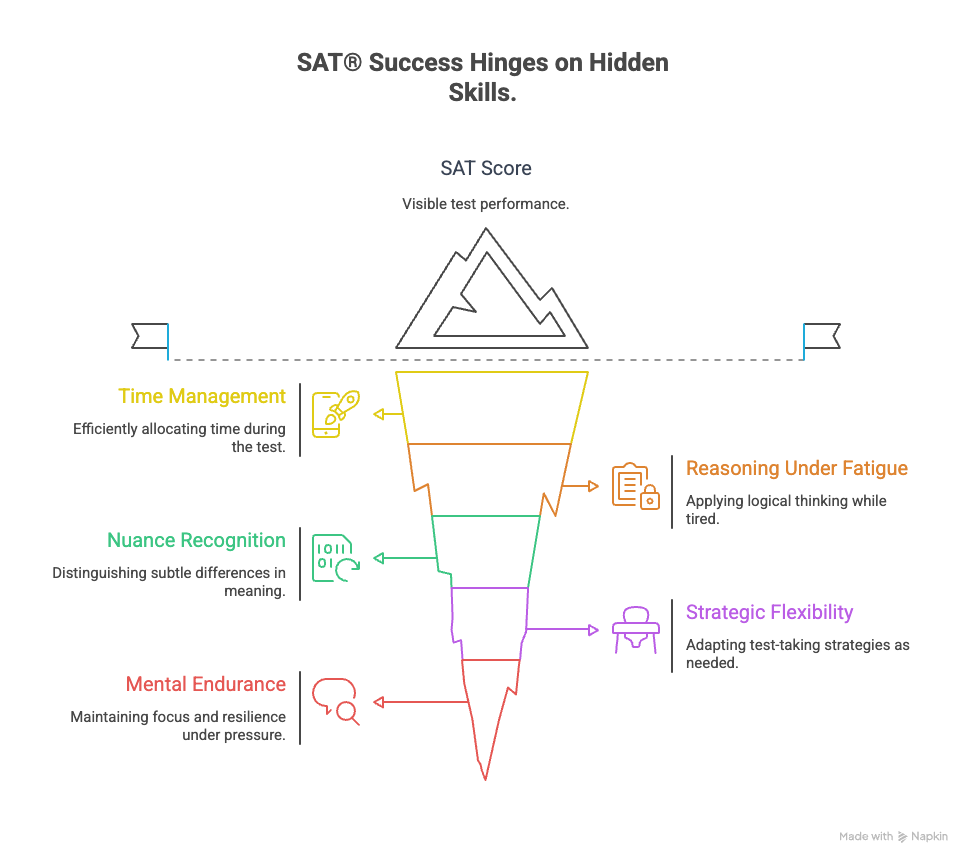You don’t need more time for SAT® prep. You need to stop treating your energy like it’s infinite.
Most students think productivity means finding the perfect calendar. But even with the best planner, the best intentions, and the best routine, you still crash during SAT® study.
You don’t run out of time. You run out of mental fuel.
If you want to actually get things done for the SAT®, with focus, quality, and sanity intact, stop managing time. Start managing energy.
Here’s the Truth Your SAT® Prep Schedule Doesn’t Show You
Your brain doesn’t operate like a clock. It runs in rhythms.
According to research on ultradian rhythms, your body and brain cycle through 90-120 minute energy waves throughout the day. After that, performance dips.
Ignore that rhythm, and you enter fatigue, distraction, and burnout. This is why a 3-hour cram session for the SAT® often leaves you drained and confused. It’s not the work. It’s how you’re managing the fuel behind it. Understanding this is vital for SAT® and mental resilience.
Mental Fatigue Is Real for SAT® Study Strategies. And It’s Invisible.
Psychologist Roy Baumeister calls this ego depletion: the gradual breakdown of self-regulation and willpower over time.
You start the day able to focus on your SAT® prep. By afternoon, decisions feel harder, attention thins, and emotions get louder. You don’t notice it at first. Then you look up, and nothing’s landing anymore.
The Real Problem with Time-Based SAT® Study Plans
Traditional SAT® study plans say things like:
- "Study 3 hours after school."
- "Wake up early and grind."
- "Use every minute of the weekend."
But these plans assume your energy is flat, constant, and controllable. It’s not.
And forcing yourself to power through when your brain is done leads to:
- Low retention of SAT® material.
- High frustration.
- False confidence in shallow work.
That’s the opposite of progress in your SAT® prep.
How to Build an Energy-Aware SAT® Study Routine
This isn’t about working less for the SAT®. It’s about working when you’re cognitively alive, and protecting that clarity. These are powerful SAT® study strategies.
1. Anchor Your High-Energy Hours for SAT® Prep
You have one to two windows per day where your brain is naturally sharper.
Try this: Track your week. When do you feel most focused without forcing it? For many teens, that’s late afternoon (4-6 p.m.) or late night (9-11 p.m., though not sustainable long term).
Use these windows for:
- Hard SAT® problem sets.
- Timed SAT® practice.
- Writing and comprehension tasks for the SAT®.
This is your deep work zone for SAT® prep. Guard it.
2. Respect the Dips in Your SAT® Study Strategies
Dips are not weakness. They’re biological.
Try this: During low-energy periods (right after lunch, late morning, early evening), do:
- SAT® flashcards.
- SAT® mistake review.
- Admin tasks (organizing notes, tracking progress, light planning for the SAT®).
Don’t waste your best brain on low-effort work. Don’t waste your worst brain on high-stakes work. This is crucial for SAT® and mental resilience.
3. Work in Sprints, Not Marathons for SAT® Prep
Your brain wasn’t designed for three-hour blocks of concentration.
Try this: Use the 90:20 model for your SAT® study:
- Study 90 minutes (maximum).
- Recover for 20 minutes.
Use the break for real recovery: move, eat, breathe, rest your eyes. Not scrolling. Think of it like athletic training for your SAT® prep. You don’t just lift for 3 hours. You train, rest, then train again.
4. Use "Energy Triggers" Before SAT® Study Starts
Focus doesn’t start at your desk. It starts with how you prime your energy for SAT® prep.
Try this: Before a study block, run a 5-minute focus ritual:
- Stretch.
- Get light exposure (sun, lamp).
- Drink water and practice deep breathing.
- No inputs for 3 minutes (avoid phone, distractions).
This isn’t wellness fluff. It’s state change, a cue that tells your mind: it’s time to engage with your SAT® study strategies.






